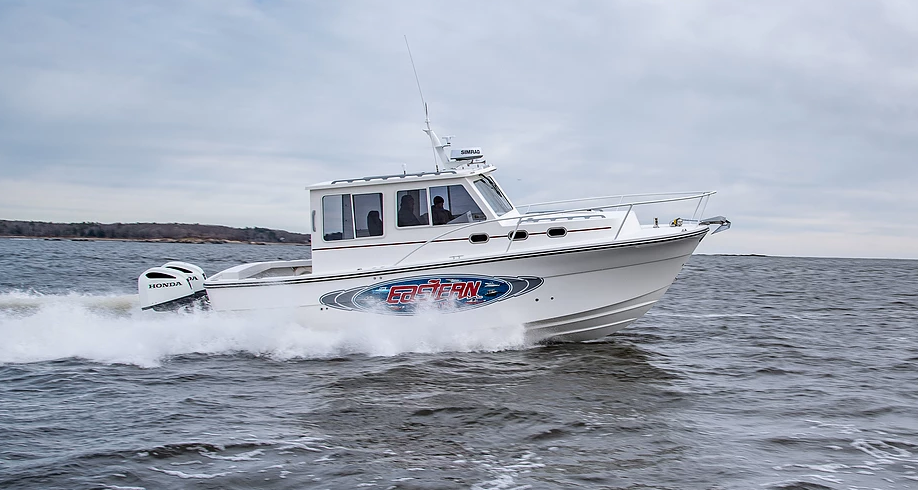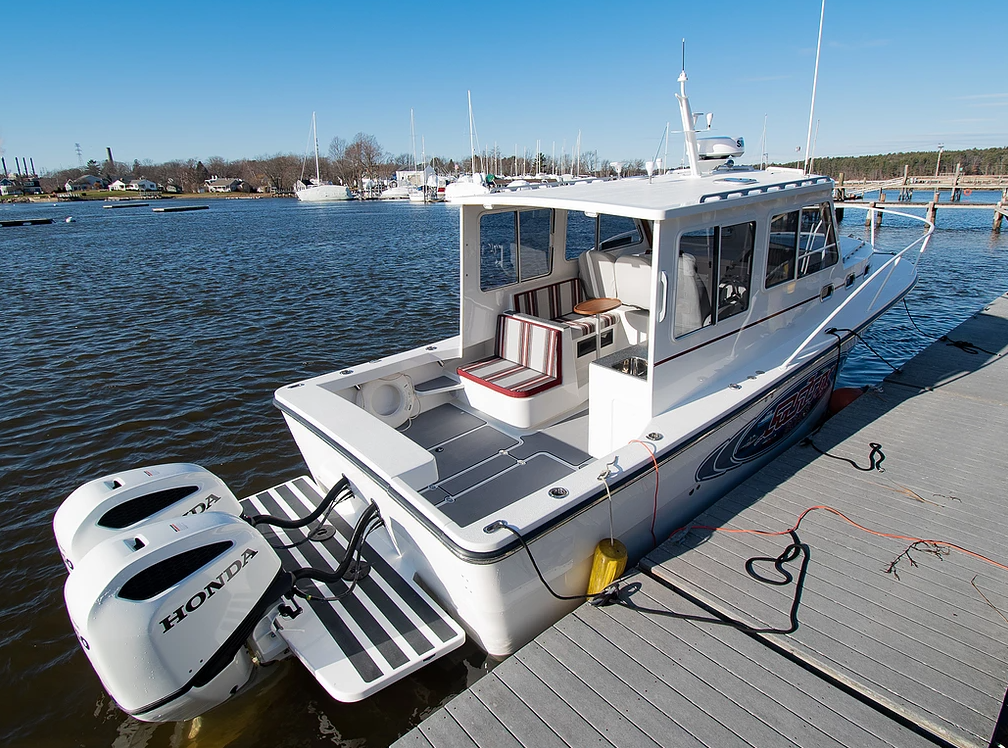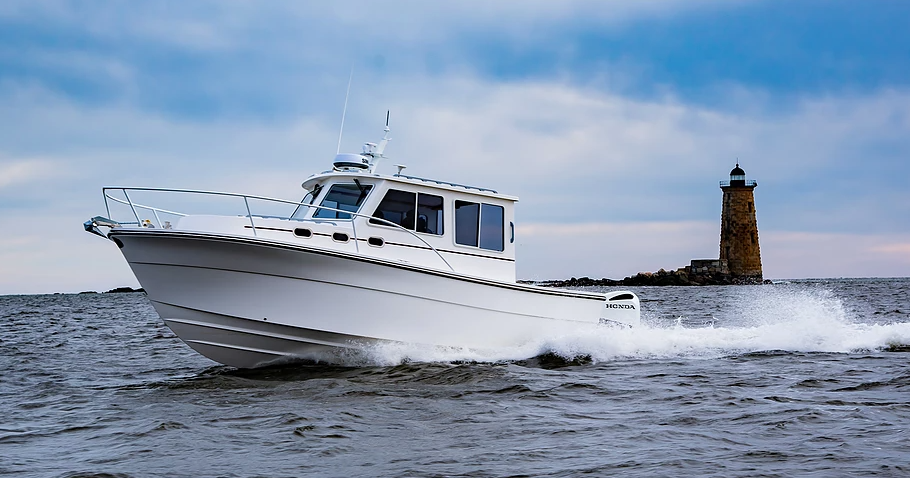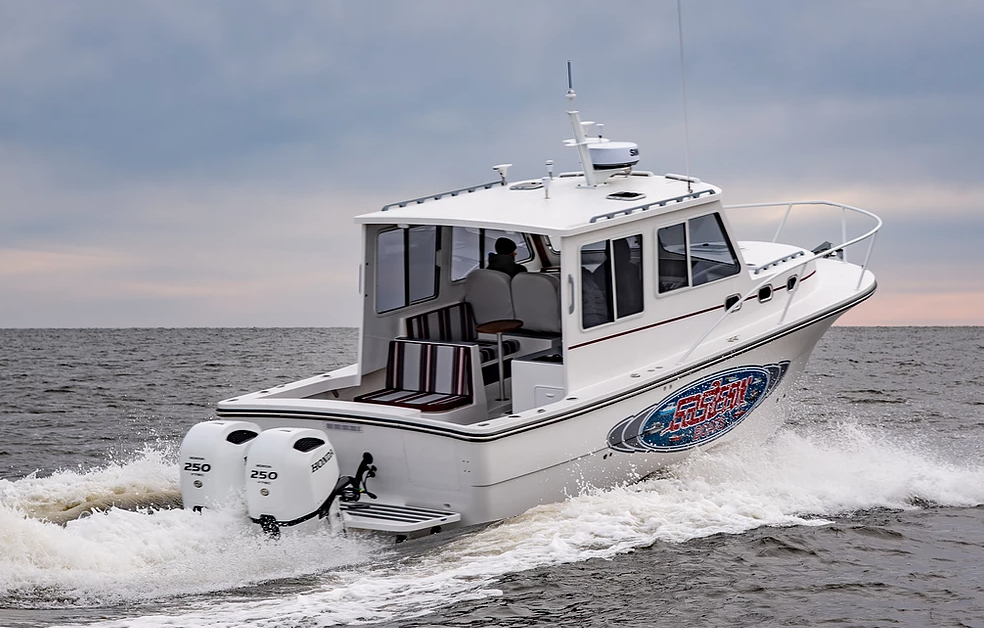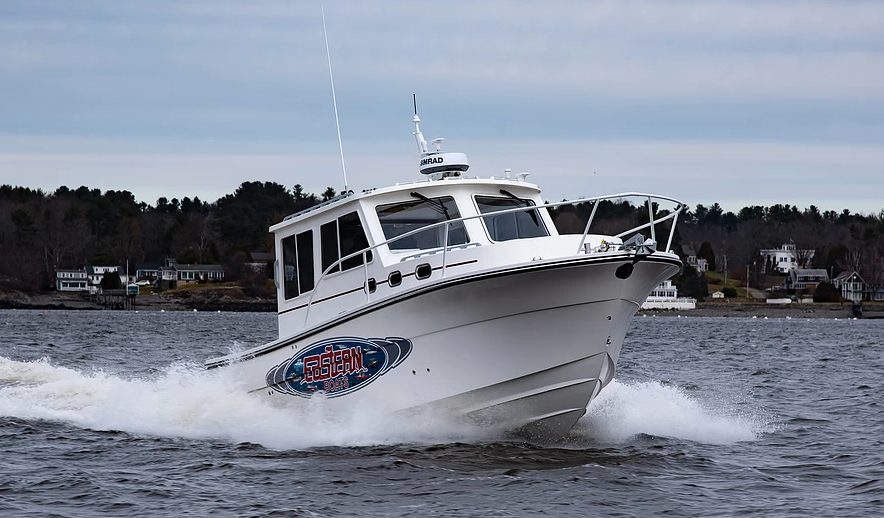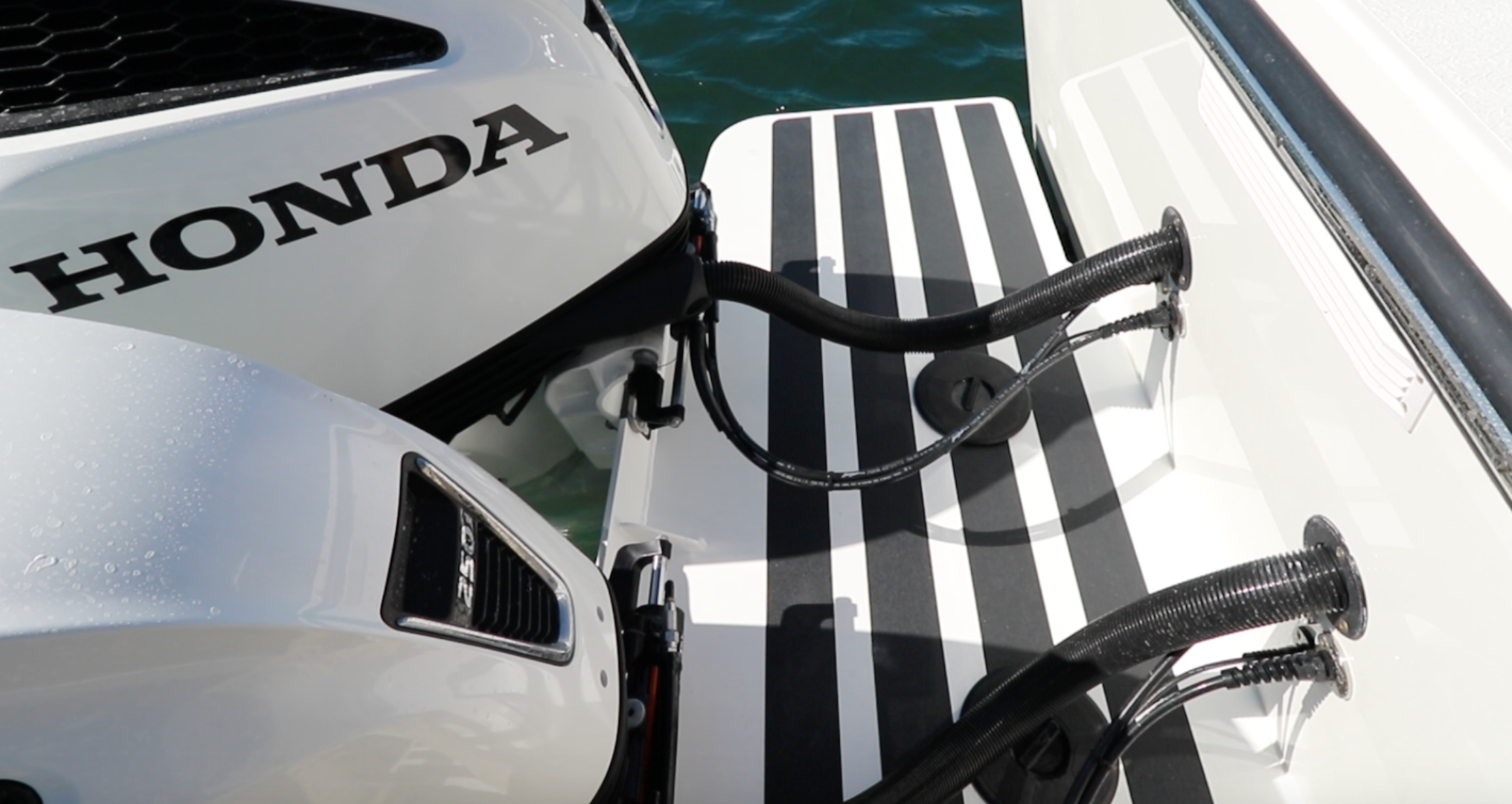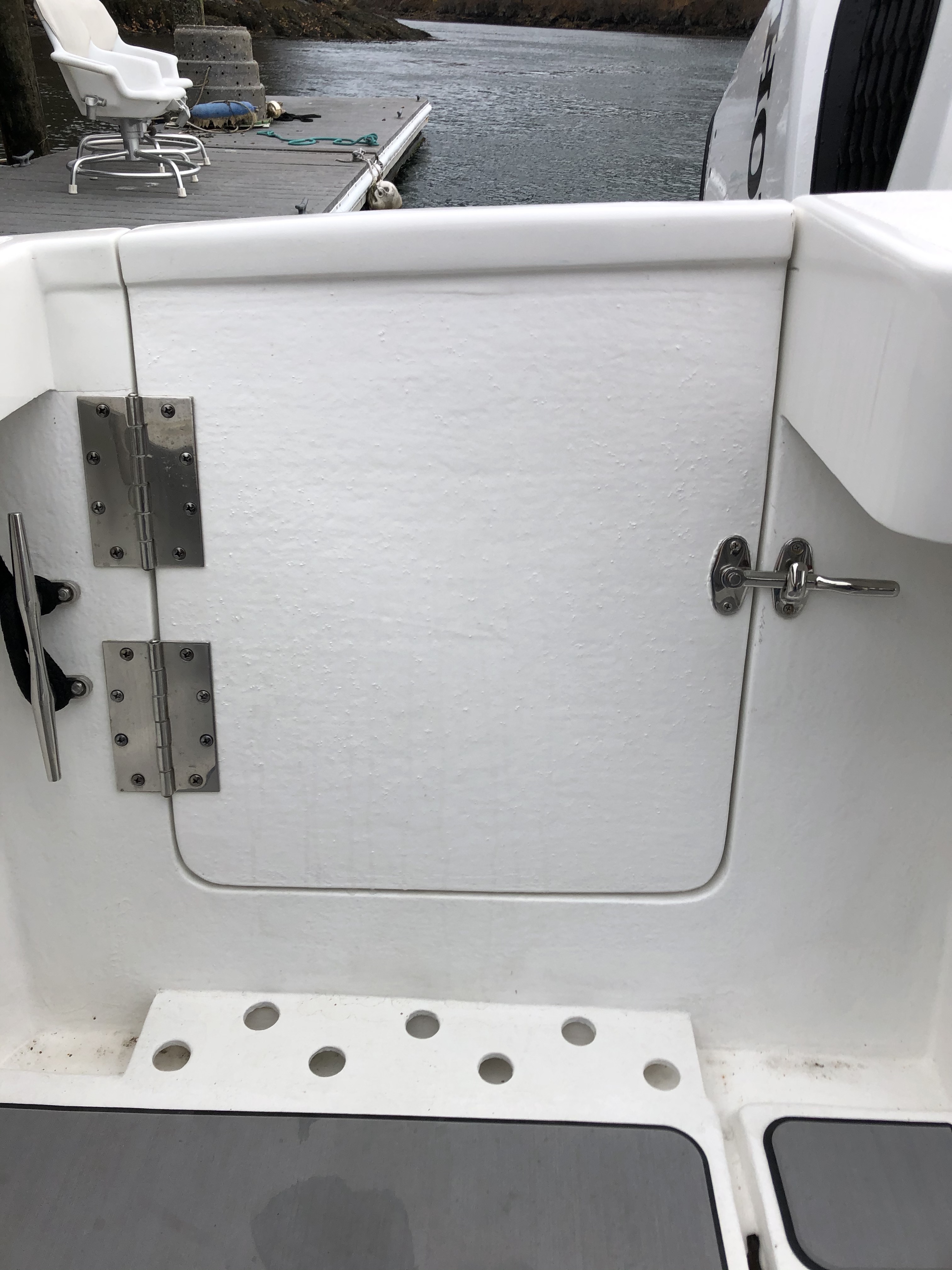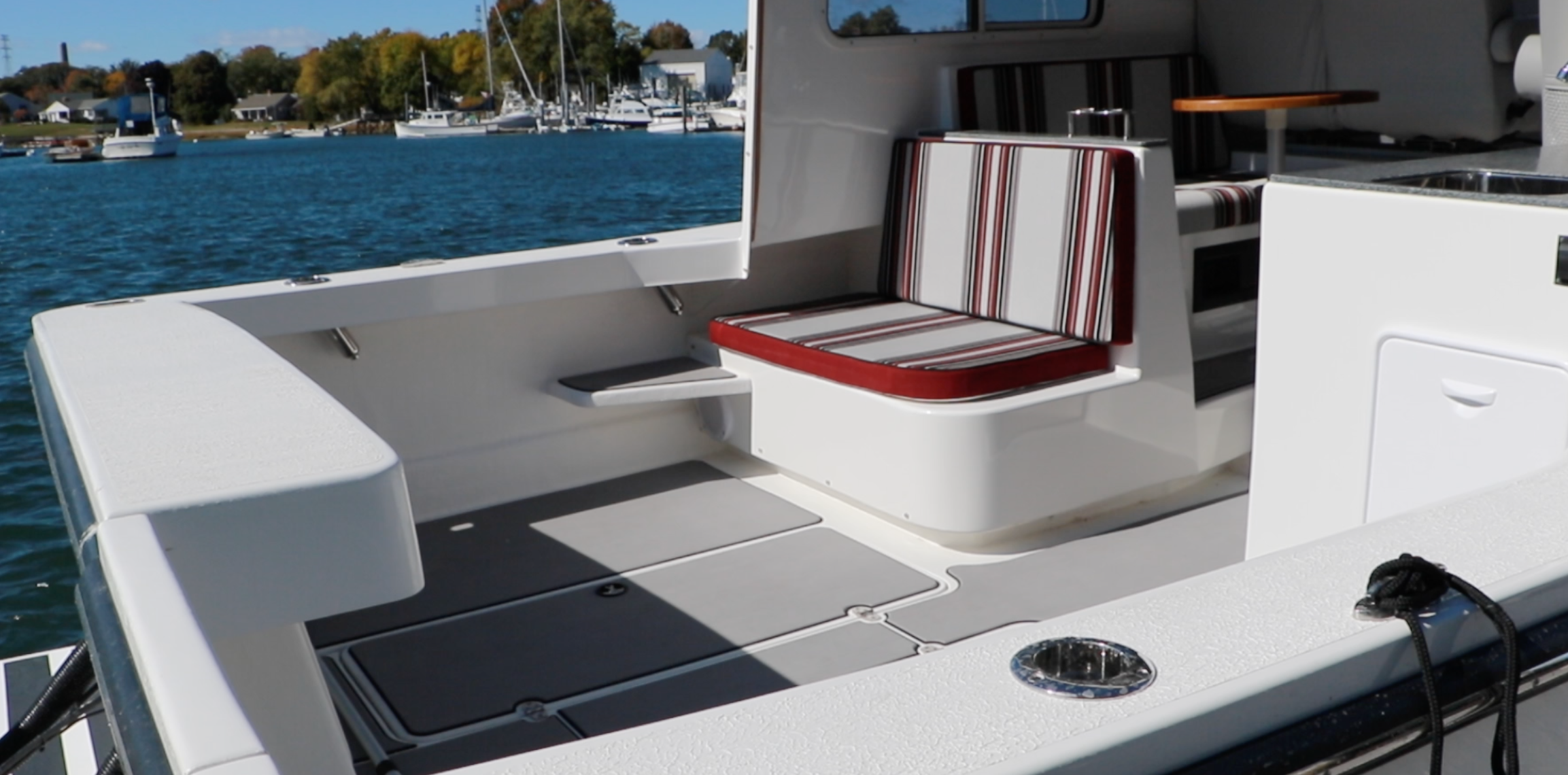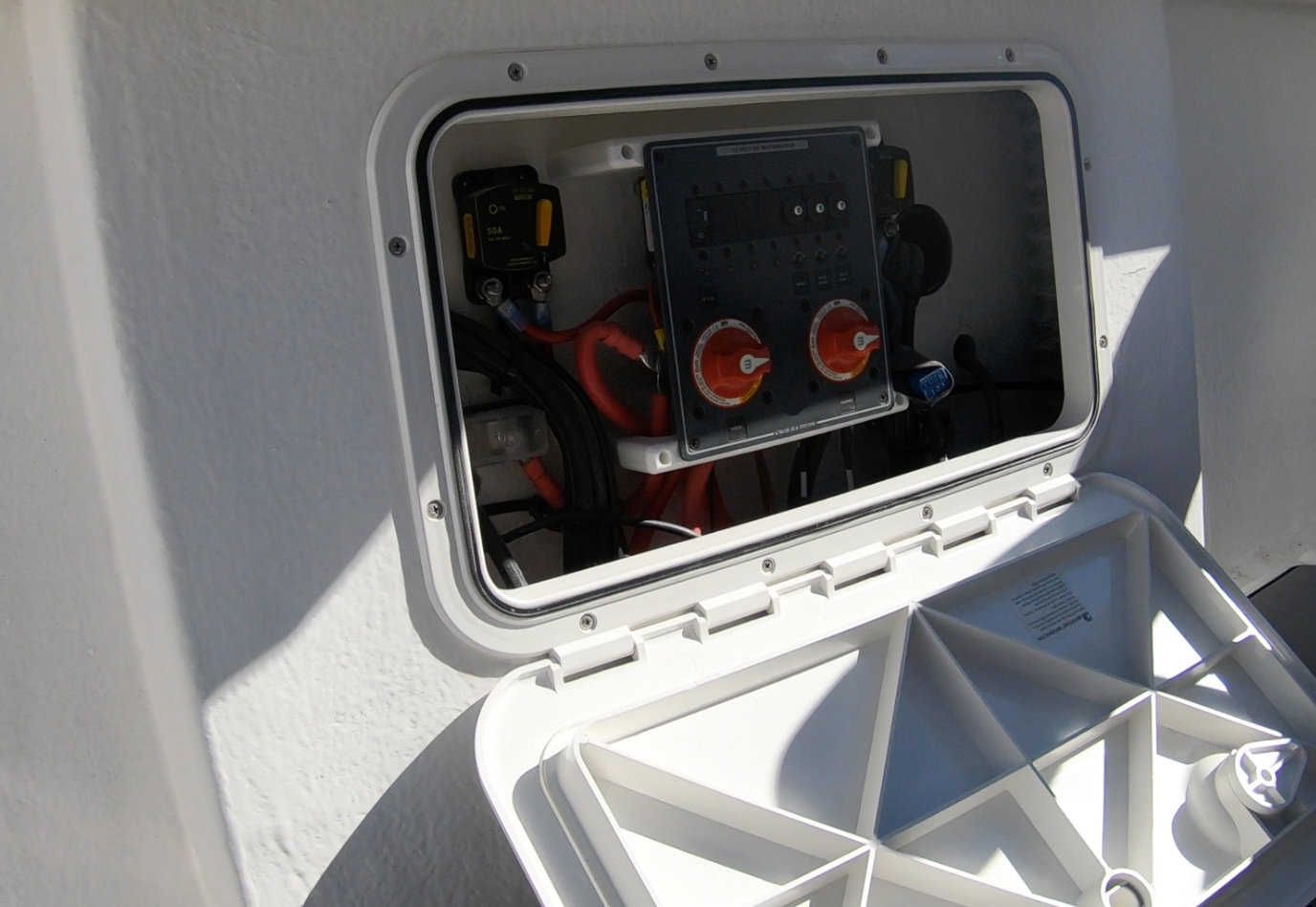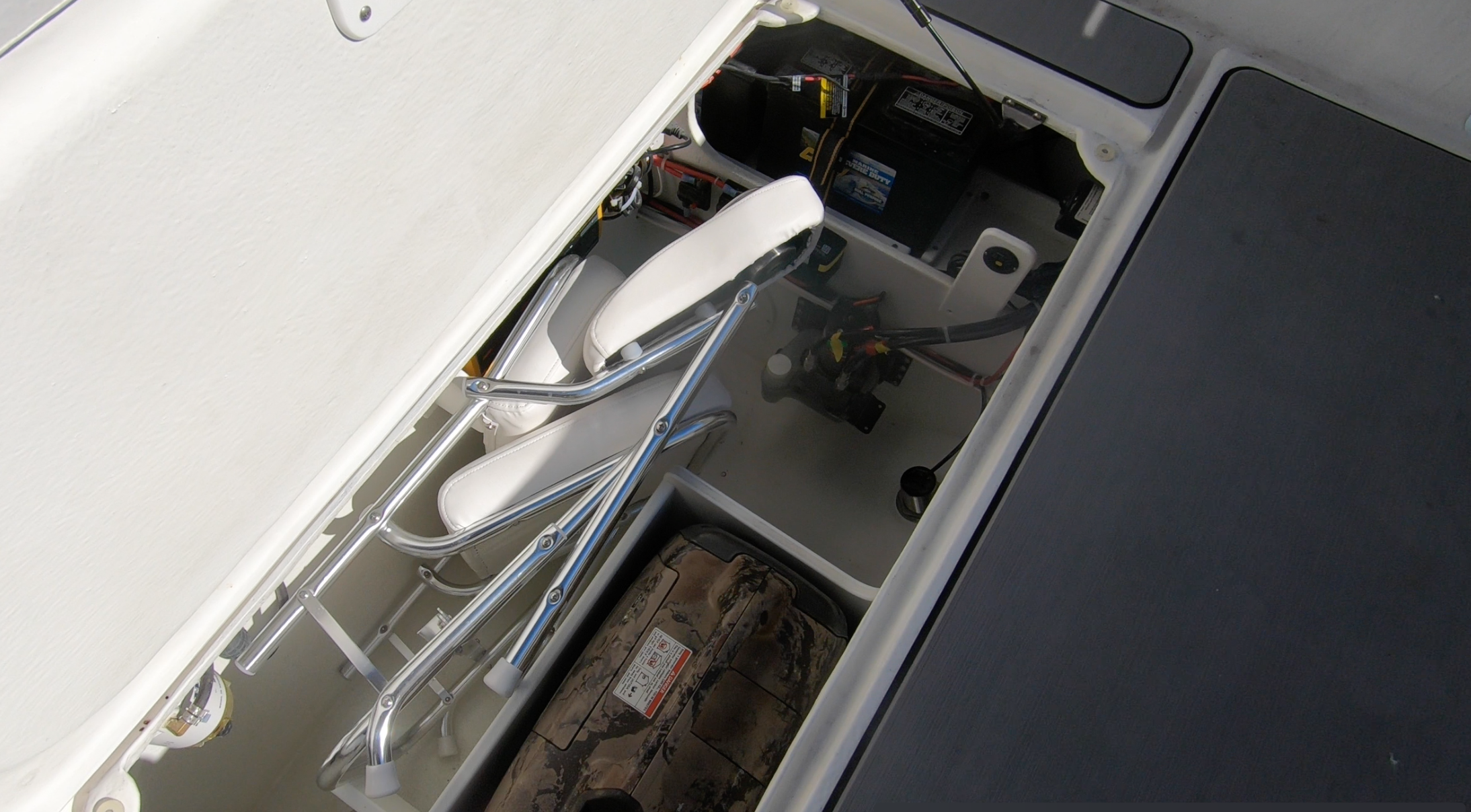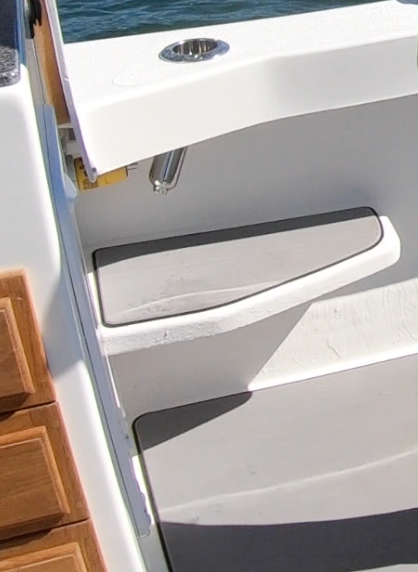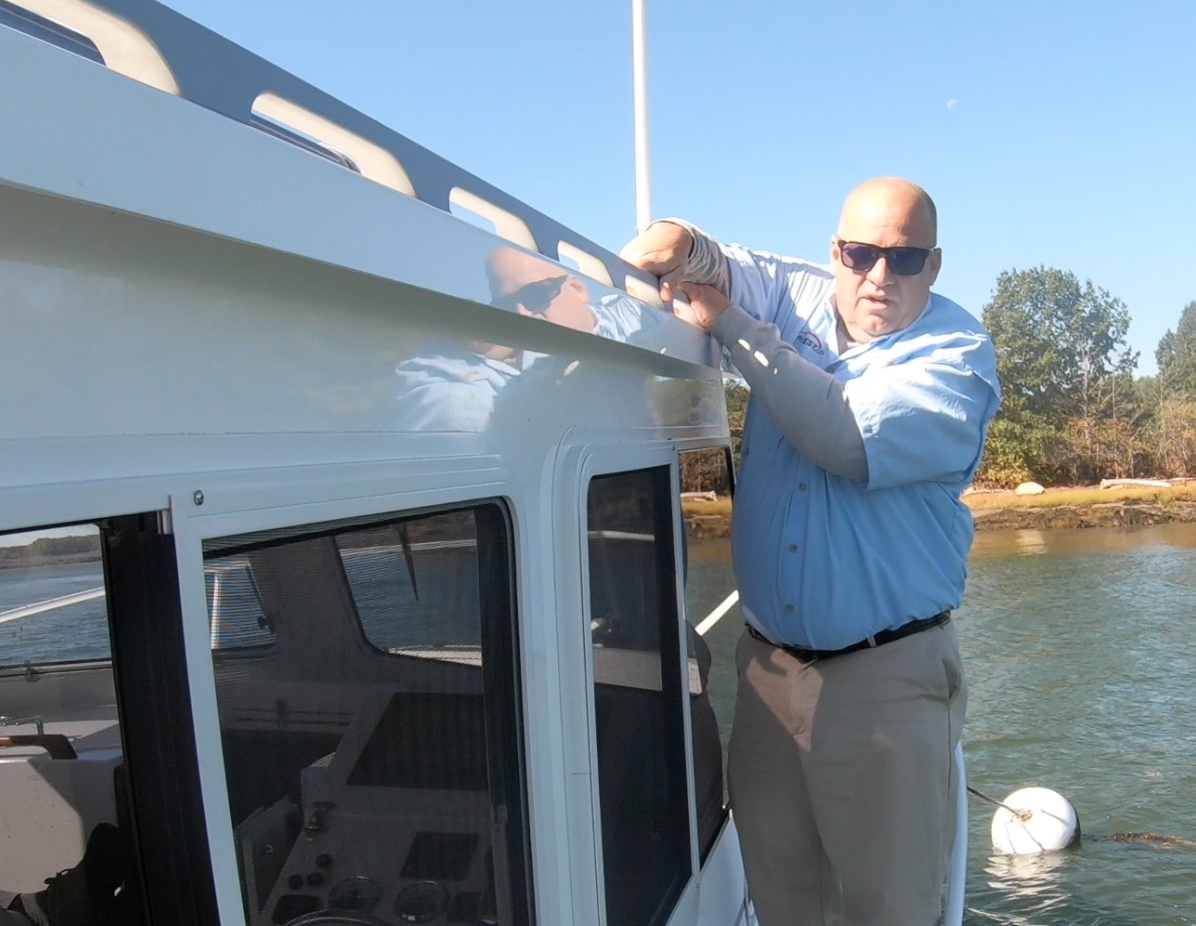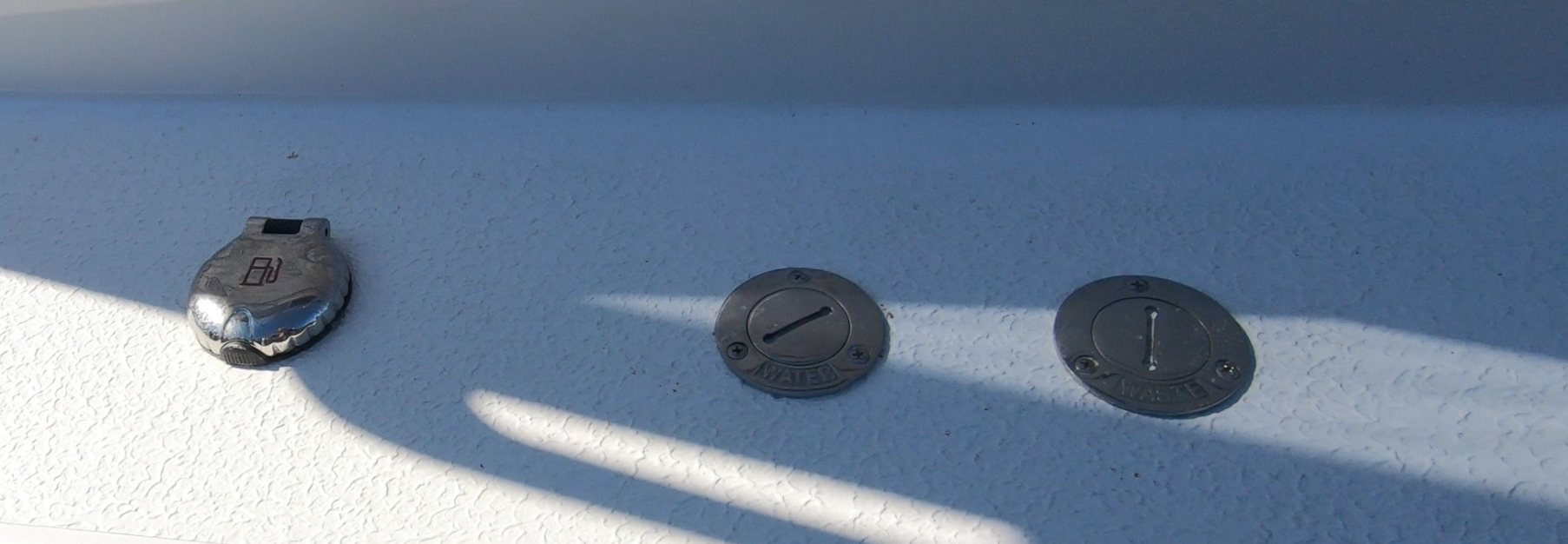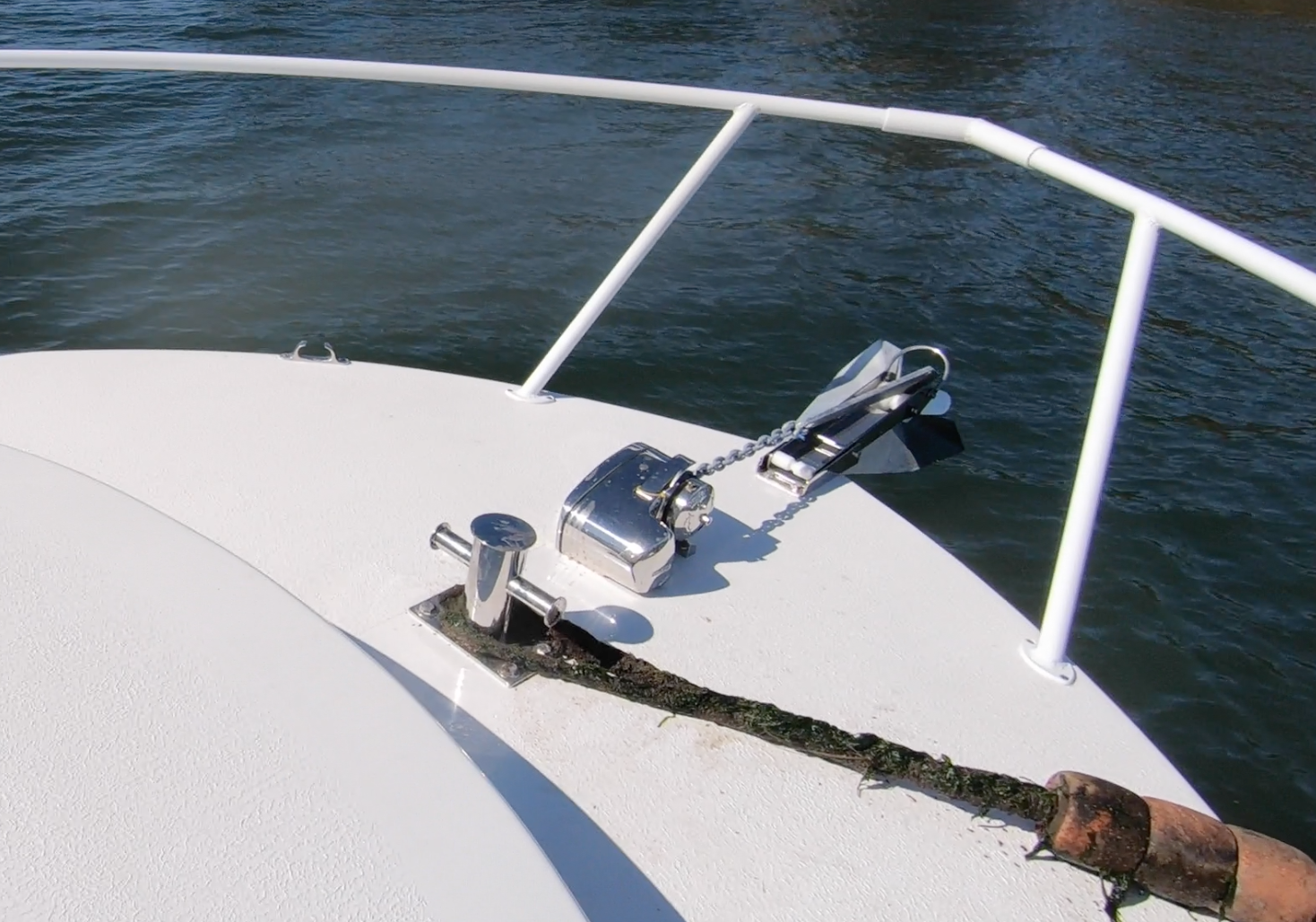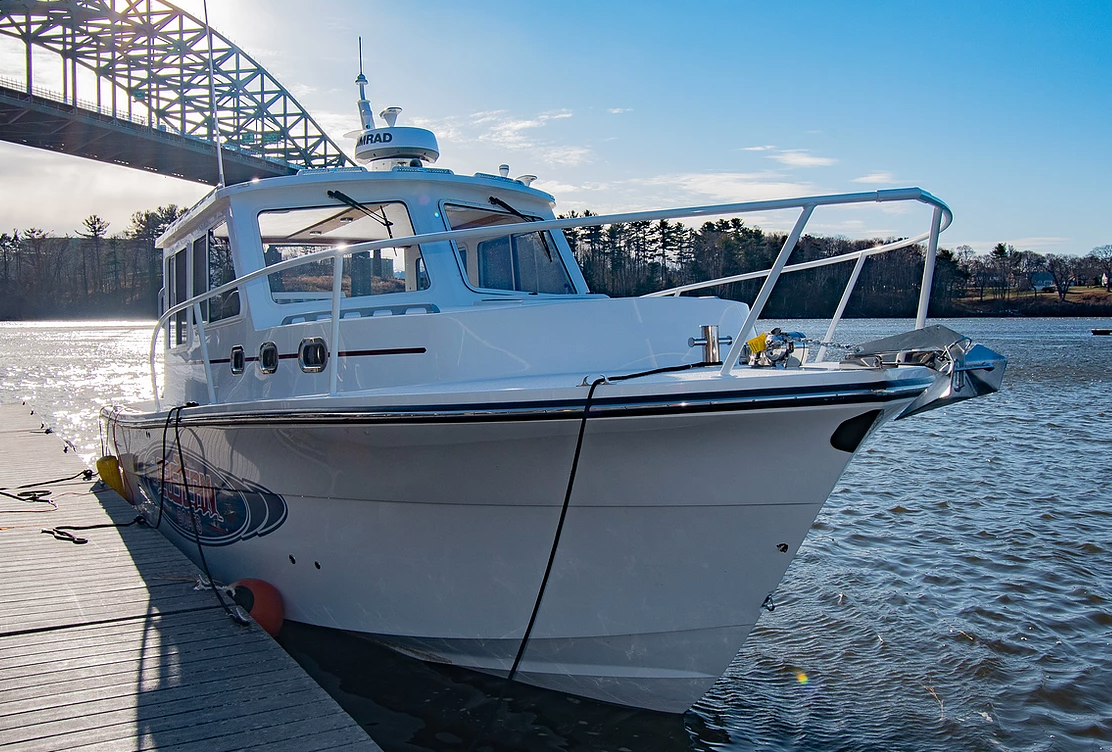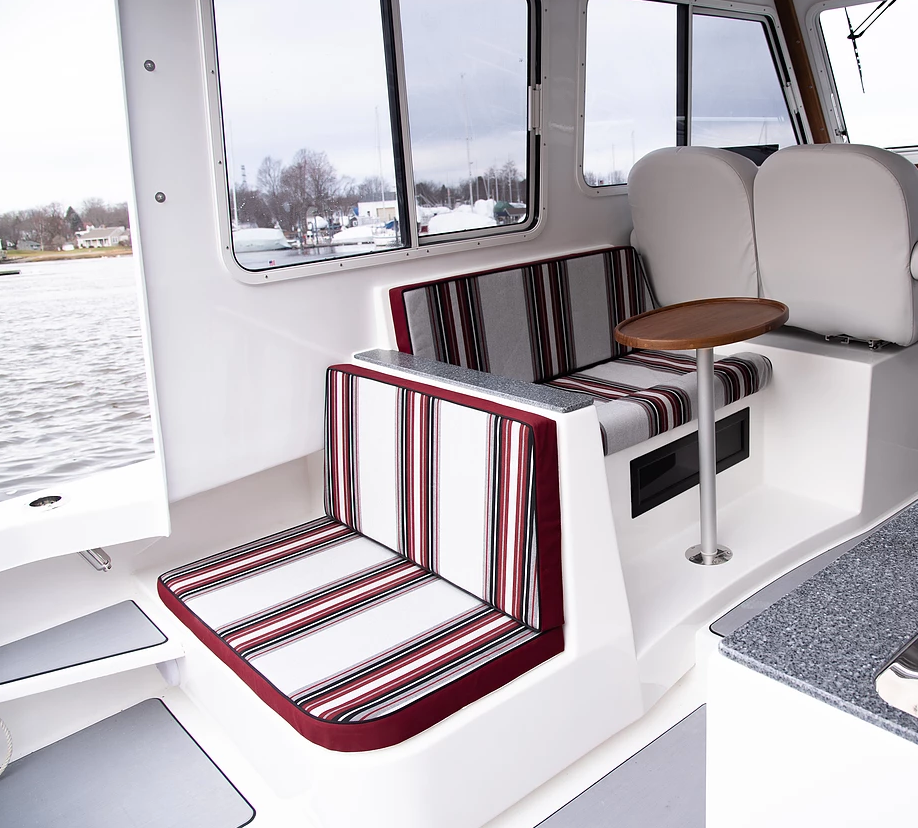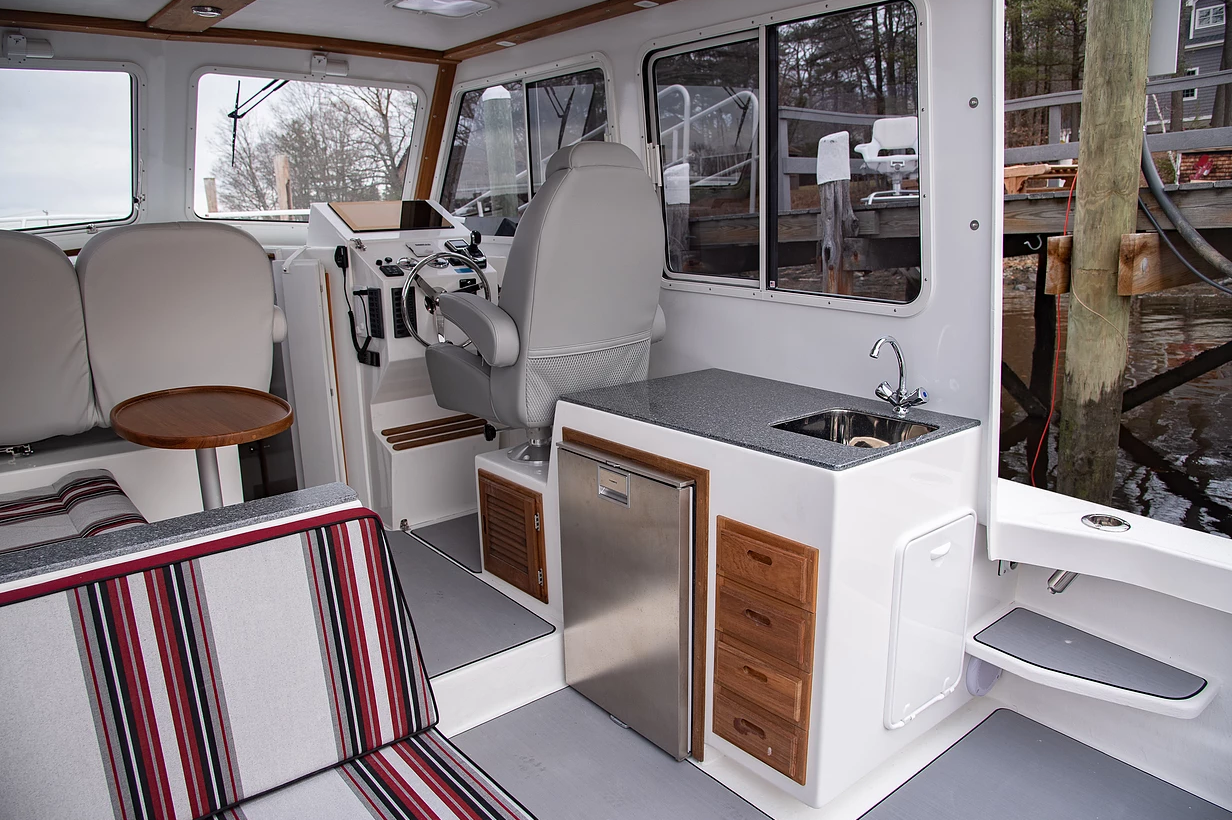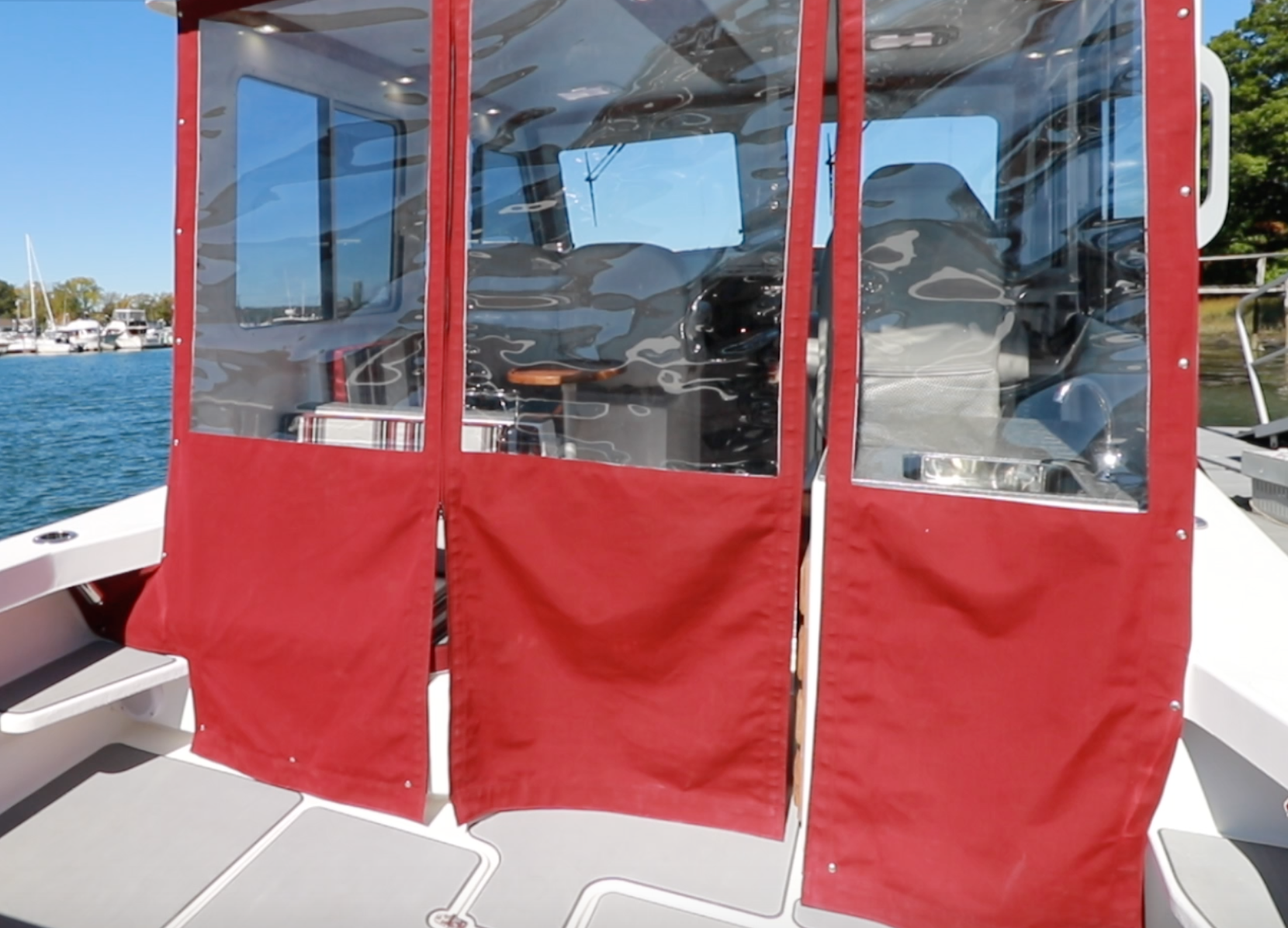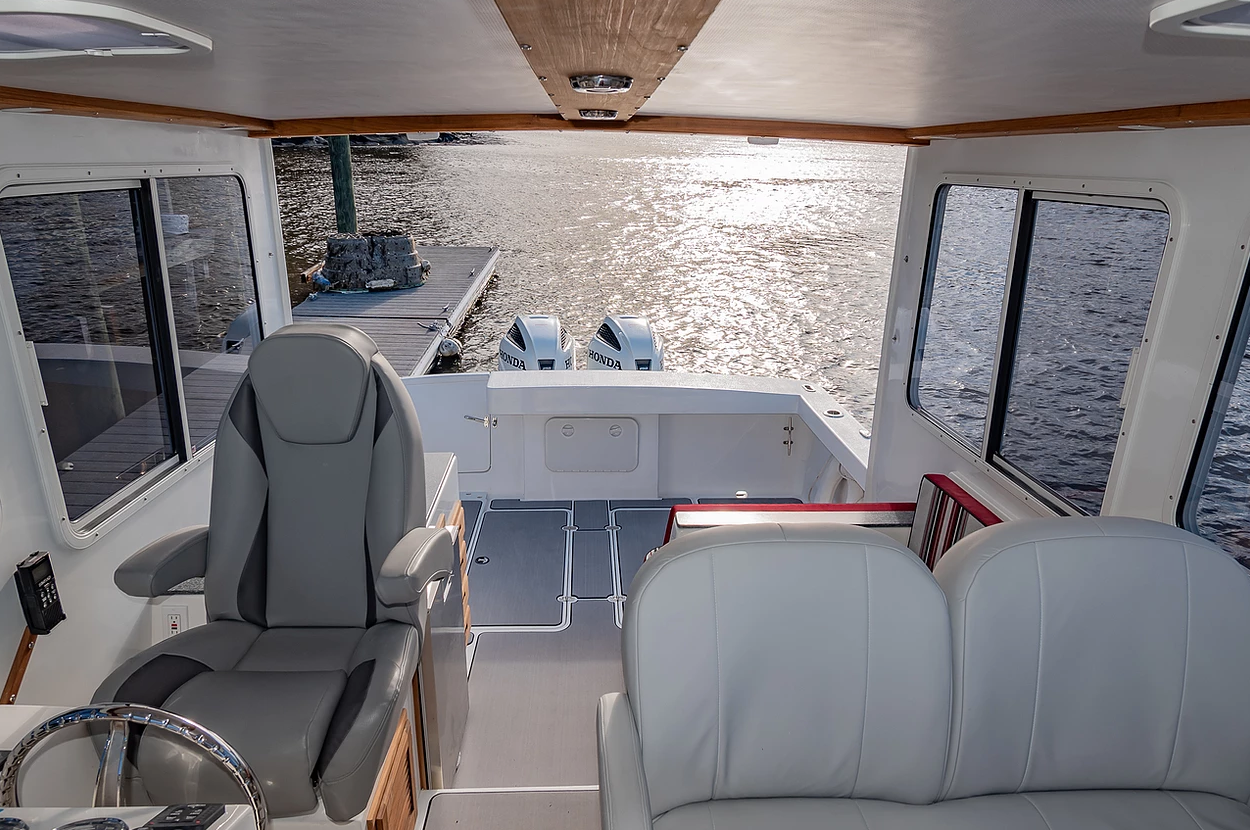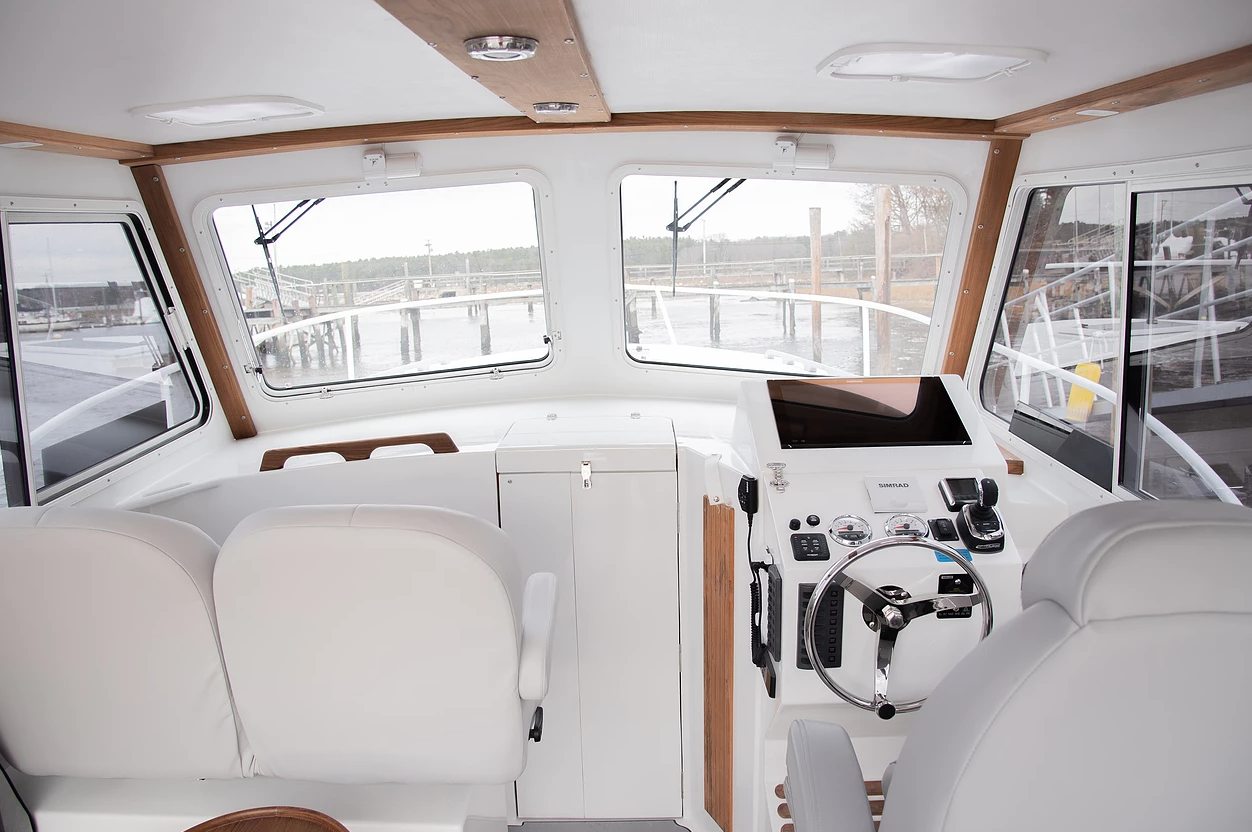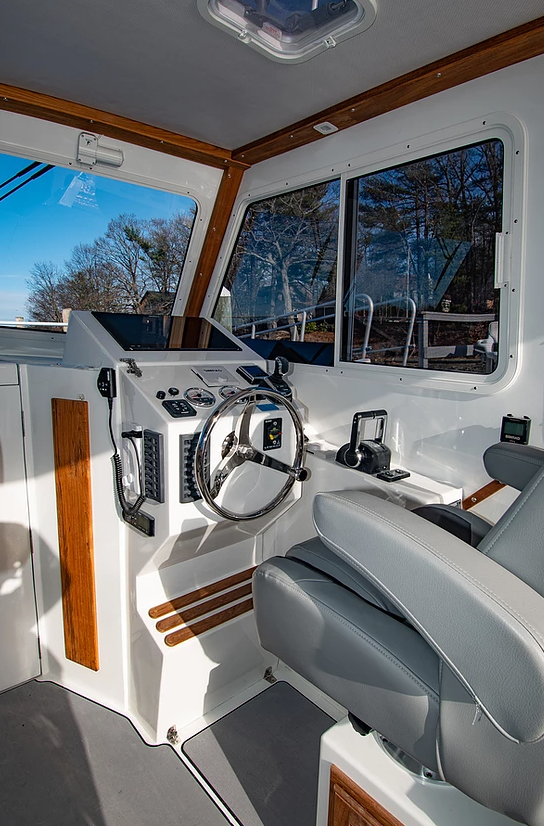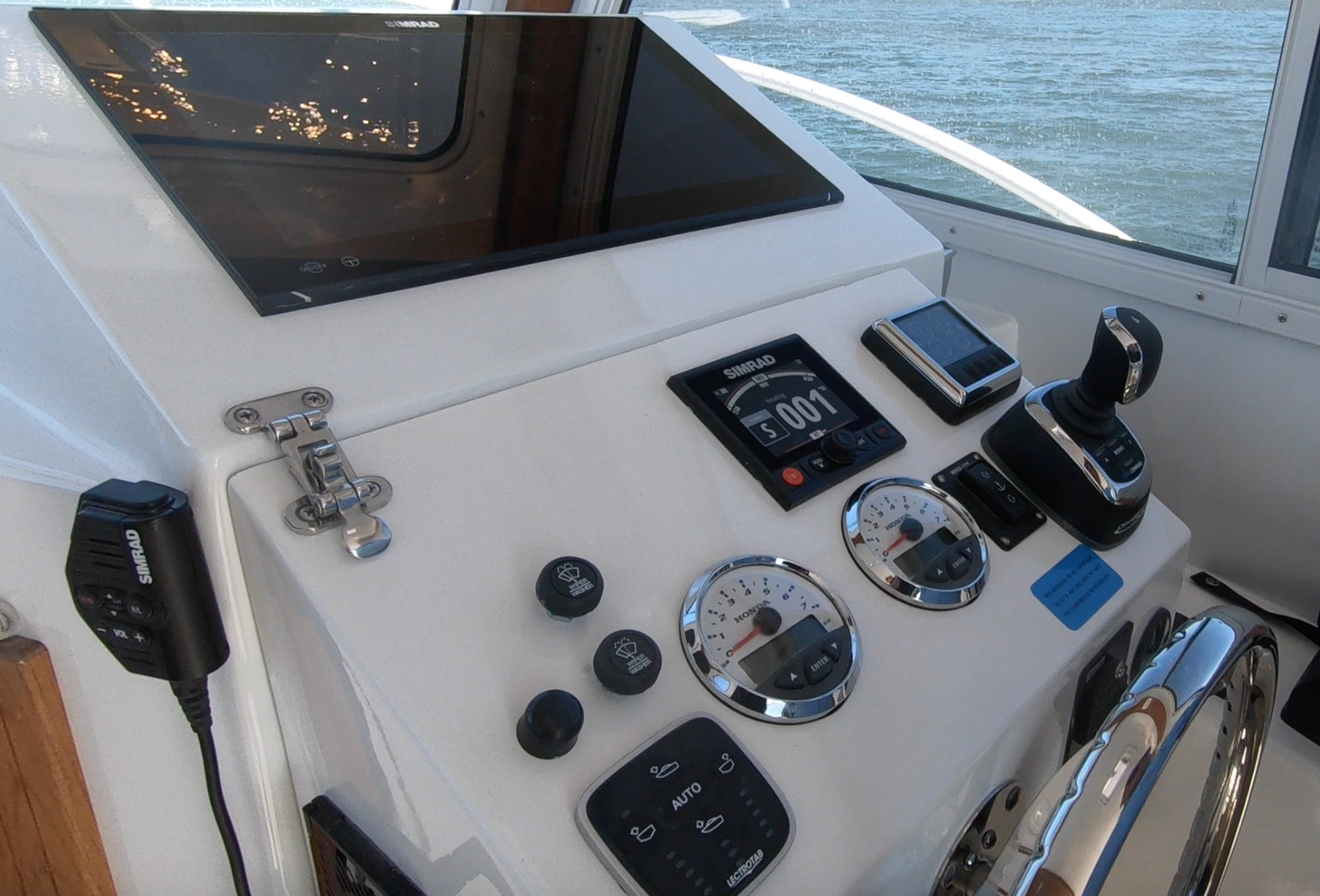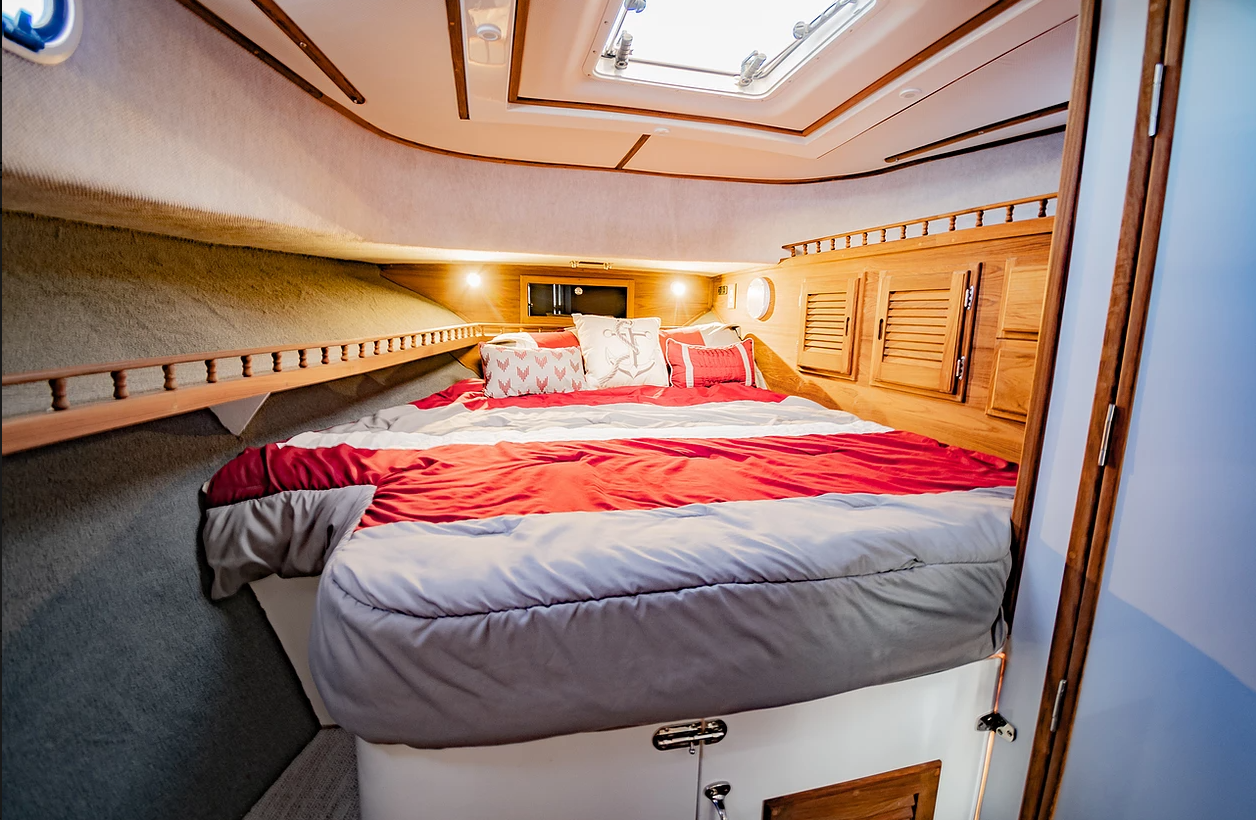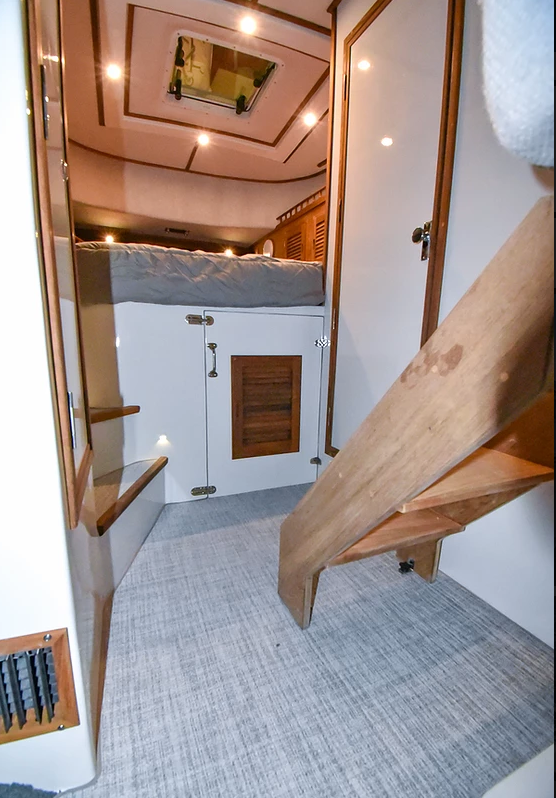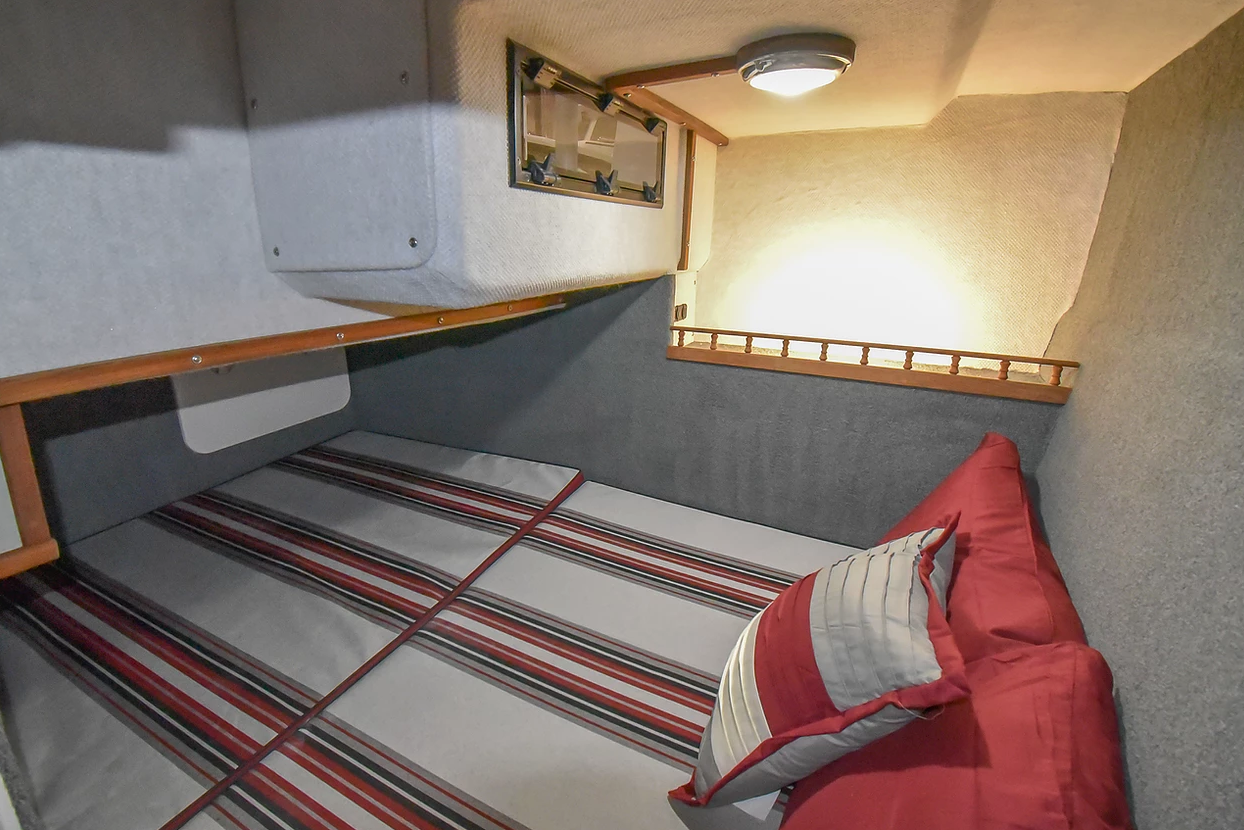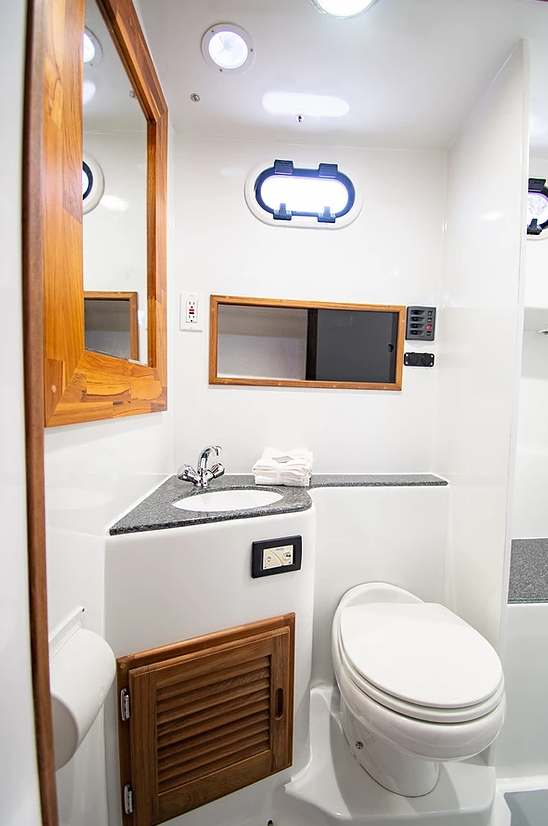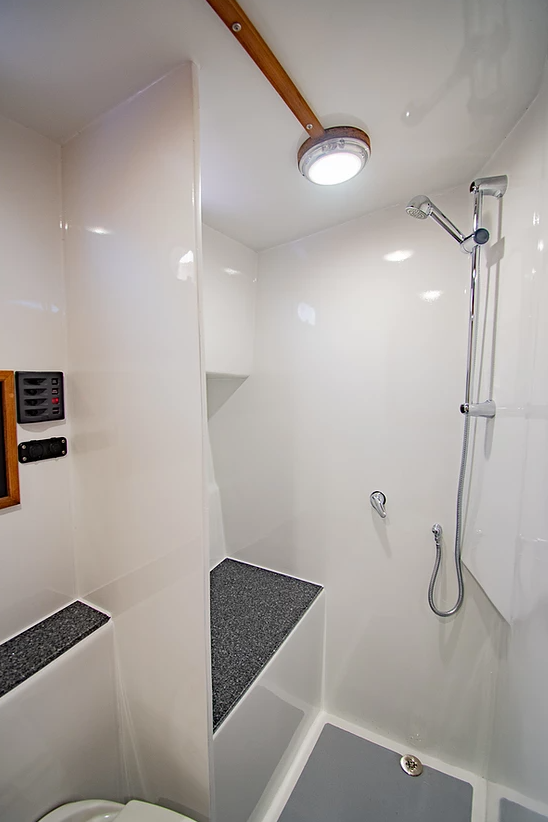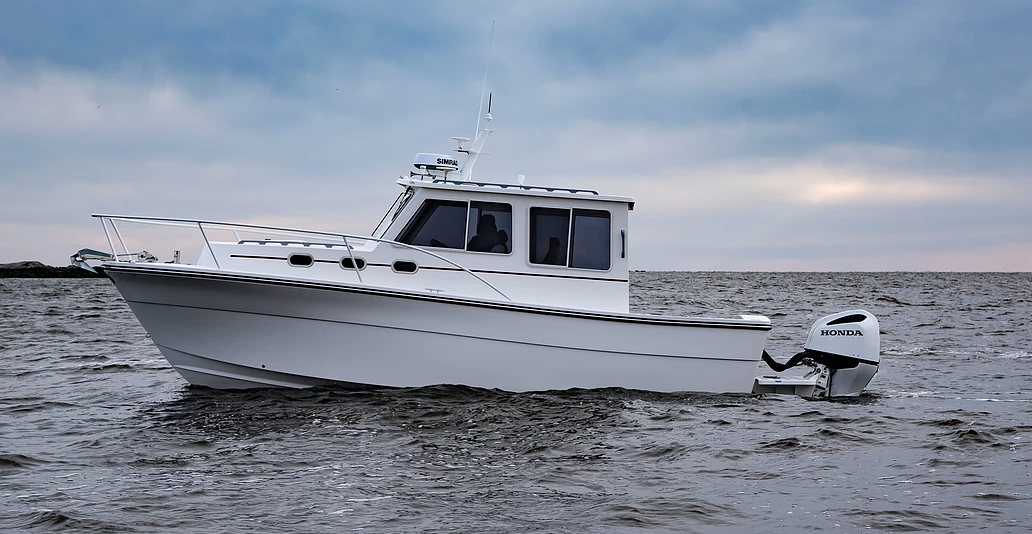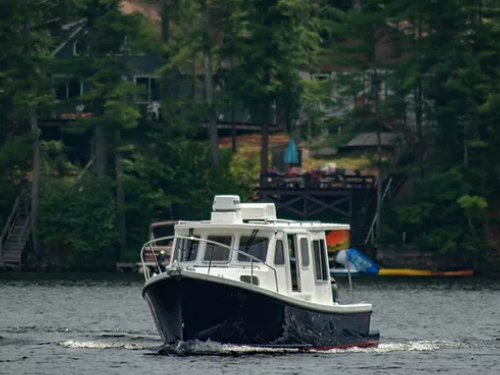Access More Boat Tests
Already have an account? Login
Eastern Boats Coastal 30 (2021-)
2 x 250-hp Honda BF250
Brief Summary
The Eastern Boats Coastal 30 is the flagship for the 40-year-old company. She mixes classic Downeast looks with a new V-bottom design and twin 250-hp four-stroke outboards.
Test Results
| RPM | MPH | Knots | GPH | MPG | NMPG | STAT. MILE | NM | dBa |
|---|---|---|---|---|---|---|---|---|
| 650 | 2.8 | 2.4 | 1 | 2.8 | 2.4 | 804 | 699.5 | 64 |
| 1000 | 5 | 4.3 | 1.6 | 3.1 | 2.7 | 914 | 794.8 | 65 |
| 1500 | 6.8 | 5.9 | 2.6 | 2.6 | 2.3 | 759 | 660.3 | 66 |
| 2000 | 8.1 | 7 | 3.3 | 2.5 | 2.1 | 718 | 624.3 | 68 |
| 2500 | 9.4 | 8.2 | 6 | 1.6 | 1.4 | 458 | 398.5 | 69 |
| 3000 | 10.5 | 9.1 | 10.3 | 1 | 0.9 | 297 | 258.1 | 73 |
| 3500 | 14.5 | 12.6 | 14.1 | 1 | 0.9 | 301 | 261.6 | 75 |
| 4000 | 21.2 | 18.4 | 17.2 | 1.2 | 1.1 | 360 | 312.8 | 78 |
| 4500 | 26.9 | 23.4 | 20 | 1.3 | 1.2 | 393 | 342.1 | 79 |
| 5000 | 32 | 27.8 | 24.6 | 1.3 | 1.1 | 380 | 330.3 | 80 |
| 5500 | 36.3 | 31.6 | 26.6 | 1.4 | 1.2 | 399 | 347.1 | 79 |
| 6000 | 37.7 | 32.8 | 28.6 | 1.3 | 1.1 | 386 | 335.3 | 78 |
| 6400 | 42.2 | 36.7 | 44 | 1 | 0.8 | 281 | 243.9 | 79 |

Specifications
| Length Overall |
29'6" 8.9 m |
|---|---|
| Beam |
11' 3.35 m |
| Dry Weight |
11,000 lbs. 4,989.52 kg |
| Tested Weight |
13,004 lbs. 5,898.52 kg |
| Draft |
22" 55.88 cm |
| Fuel Capacity |
325 gallons 1,230.26 L |
| Total Weight |
13,004 lbs. 5,898.52 kg |
Acceleration Times & Conditions
| Time to Plane | 6.5 seconds |
|---|---|
| 0 to 30 | 11.4 seconds |
| Props | 14 1/4" x 17" 3-blade SS (36.20 cm x 43.18 cm) |
| Load | 2 persons; 162.5 gallons fuel; 50 lbs. gear |
| Climate | 72 deg.; 84 humid.; winds: 5-10; seas: flat |
Engine Options
| Tested Engine |
2 x Honda BF250 |
|---|
Captain's Report
Report by Eric Colby
Mission Statement
Eastern is known for its line of Downeast-style outboard-powered boats. While most of the fleet has traditional lobster-boat-style hull bottoms, the new Coastal 30 has a more contemporary V bottom with four strakes and a hard chine. Twin outboards open up storage in the cockpit and allow more versatility in the boat’s overall design. She’s a coastal cruiser that sleeps four and has a separate shower in the head.
Eastern Boats Coastal 30 Major Features
- Twin outboards up to 500 hp total
- Large cockpit
- Cockpit galley
- Three-sided pilothouse
- Opening pilothouse windows
- Separate shower stall
- Almost 7’ (2.13 m) of headroom belowdecks
Eastern Boats Coastal 30 Performance
The Specifications. The Coastal 30 has an LOA of 29’6” (8.99 m), a beam of 11’ (3.35 m) and a hull draft of 22” (55.88 cm). With an empty weight of 11,000 lbs. (4,989.52 kg), 162.5 gallons (615.13 L) of fuel, and two people onboard, we had an estimated test weight of 13,004 lbs (5,898.52 kg). Twin 250-hp Honda BF outboards were turning 14 ¼” x 17” (36.20 cm x 43.18 cm) three-blade stainless-steel propellers through 2:1 reductions.
The Numbers. Winding up the twin Hondas to 6400 rpm, we hit our top speed of 42.2 mph. Best cruise came at 5500 rpm, where we measured 36.3 mph and burned 26.6 gph. This gave us 1.4 mpg and a range of 399 statute miles with 10 percent of the boat’s 325-gallon (1,230.26-L) fuel capacity held in reserve. At 650 rpm, the boat ran 2.8 mph and burned 1.0 gph, giving her a rating of 2.8 mpg. Bump up to 1000 rpm and the speed goes to 5.0 mph with a fuel burn of 1.6 gph and 3.1 mpg.
When we pinned the throttles forward, the Coastal 30 planed and hit 20 mph in 6.5 seconds and ran through 30 mph in 11.4 seconds.
Handling. The Coastal 30 comes standard with hydraulic steering and it makes the boat a nimble performer. Our test boat transitioned quickly from side to side when crossing wakes and held her line with assurance when making arcing turns. Around the docks, the optional bow thruster made maneuvering a breeze.
Eastern Coastal 30 Features Inspection
The Stern. The outboard bracket on the Coastal 30 doubles as the swim platform. It measures 94” (238.76 cm) wide and 34” (86.36 cm) front to back. All the hoses and wires for the engines pass cleanly through fittings in the transom.
The Cockpit. A gate to starboard opens inboard for entry to the cockpit that measures 110” (279.4 cm) wide and 56” (142.24 cm) fore to aft. The deck is finished in SeaDek mat. In each aft corner are hawse holes that lead to 10” (25.4 cm) vertically installed cleats and just ahead in the caprail are combination rod/beverage holders, plus a fold-up cleat for fenders. A hatch in the transom opens to access the battery switches and circuit breakers. Twin hatches in the center of the deck open to access cavernous storage. There’s enough depth to store folding chairs inside and access to mechanical equipment including the batteries, inverter, charger, bilge pumps, fuel-water separators and through-hull fittings is wide open. On the trailing edge of the hardtop, our test boat was equipped with an optional SureShade extendable awning.
Forward Passage. Steps in the inwale on each side make it easy to head forward on the side decks that measure 11” (27.94 cm) wide aft and spread out to 14” (35.56 cm) at the bow. There’s another 10” (25.4 cm) clean in the side deck that we’d like to see swapped out for a pull-up version. Rails on top of the pilothouse are appreciated and the waste outlet and water and fuel fills are in the starboard deck just outboard of the sliding window alongside the helm so the captain can see when pulling up to a fuel dock or pump-out station. Forward, the bow rail is 24” (60.96cm) off the deck in comfortable reach.
The Bow. Forward, the Coastal 30’s foredeck is raised to provide more headroom for the cabin. There’s a bollard-style cleat abaft the windlass and chocks on each side. The bowrail starts alongside the pilothouse and is 24” (60.96 cm) off the deck.
Cockpit Seating. Back in the cockpit, to port is an aft-facing seat that’s 39 ½” wide (99.06 cm), 23” (58.42 cm) fore to aft and it has an 18” (45.72 cm) tall backrest. There’s storage in the base and the bottom cushion snaps in place so it won’t blow out. Just ahead are a similarly-sized inboard-facing lounge outboard of a table. All the side windows in the pilothouse slide open easily and have screens. If an owner wants to extend the season, the boat comes with curtains that close off the pilothouse.
The Galley. Opposite to starboard is the cockpit galley. A tilt-out hatch on the aft end of the reveals a wastebasket. A stainless-steel sink is recessed into the countertop that has 625 sq. inches (4,025.80 sq. cm) of prep area. We’d like to see a fiddle rail to contain spills. In the base are four teak drawers that exhibit outstanding craftsmanship plus a Dometic refrigerator.
The Helm Deck. Continuing forward, to port is a companion seat that measures 51” (129.54 cm) wide and has an adjustable backrest. In the port forward corner of the counter is an integrated grab handle and there’s a teak rail just ahead. To let in fresh air on a hot day, the port windshield can be partially opened and held in position with stanchions that secure in place. To starboard, the captain’s chair has a fold-up bolster and armrests. It also slides fore and aft. The helm has an optional 18” (45.72 cm) Simrad multifunction display up high. Below are the Optimus control pad, the Simrad autopilot, the trim tab panel with built-in indicators, Honda tachometers with scroll-through displays and the windlass control. Outboard to starboard are the optional Optimus joystick, a Simrad remote for the chart plotter and Honda’s Intelligent Shift and Throttle digital controls.
The Forward Berth. A centrally positioned two-piece hatch opens the entryway to the Coastal 30’s cabin. Descend four teak steps and in the central foyer area, there’s 6’9” (2.06 m) of headroom. Two steps make it easier to get into the bow berth that measures 79” (200.66 cm) long and 67” (170.18 cm) at its widest. A rail creates a long shallow shelf to port. Outboard to starboard is storage in lockers and drawers plus another shelf with a rail on top. The overhead deck hatch lets in natural light and has a screen so it can remain open to let in fresh air. A provisions locker in the base of the berth gives an idea of the added interior volume the new hull design provides. Inside are the Dometic reverse-cycle AC unit, plus two storage shelves that measure more than 7’ (2.13 m) long. Height inside the compartment is 42” (106.7 cm). A rolled-up liferaft would easily fit inside. To starboard, the hanging locker is 53” (134.62 cm) tall and 28” (71.12 cm) deep. Teak rails on top create another shelf and there are two screened opening ports in the hullside.
The Mid Cabin. Abaft the hanging locker, the mid-cabin has a berth that’s 74” (187.96 cm) wide and 54” (137.16 cm) fore to aft. There’s a single light plus a screened port that looks out into the cockpit.
The Head. At the base of the cabin stairs is the entry to the private head. Inside, there’s a sink, a toilet, a mirror and storage. Here’s something we don’t see on many 30’ (9.14 m) boats - a separate shower stall. Headroom in this area is 6’3” (1.9 m) and there are two more Lewmar opening ports that help let in fresh air and release steam.
Price
With twin Honda BF250 four-stroke outboards, retail price of the Coastal 30 is $325,000.
Observations
The Eastern Boats Coastal 30 is a logical next step for the company going forward. She has a new, more conventional bottom design and having the outboards hanging off the stern creates more usable space in the cockpit, pilothouse and cabin. She’s built with added weight placed low in the boat to make sure she can maintain a good ride in less-than-ideal conditions.
Eastern is looking at some alternative seating layouts in the pilothouse with convertible backrests or other options that could enhance the Coastal 30’s versatility. The company will also offer the boat with outboards from Mercury, Yamaha and Suzuki.

